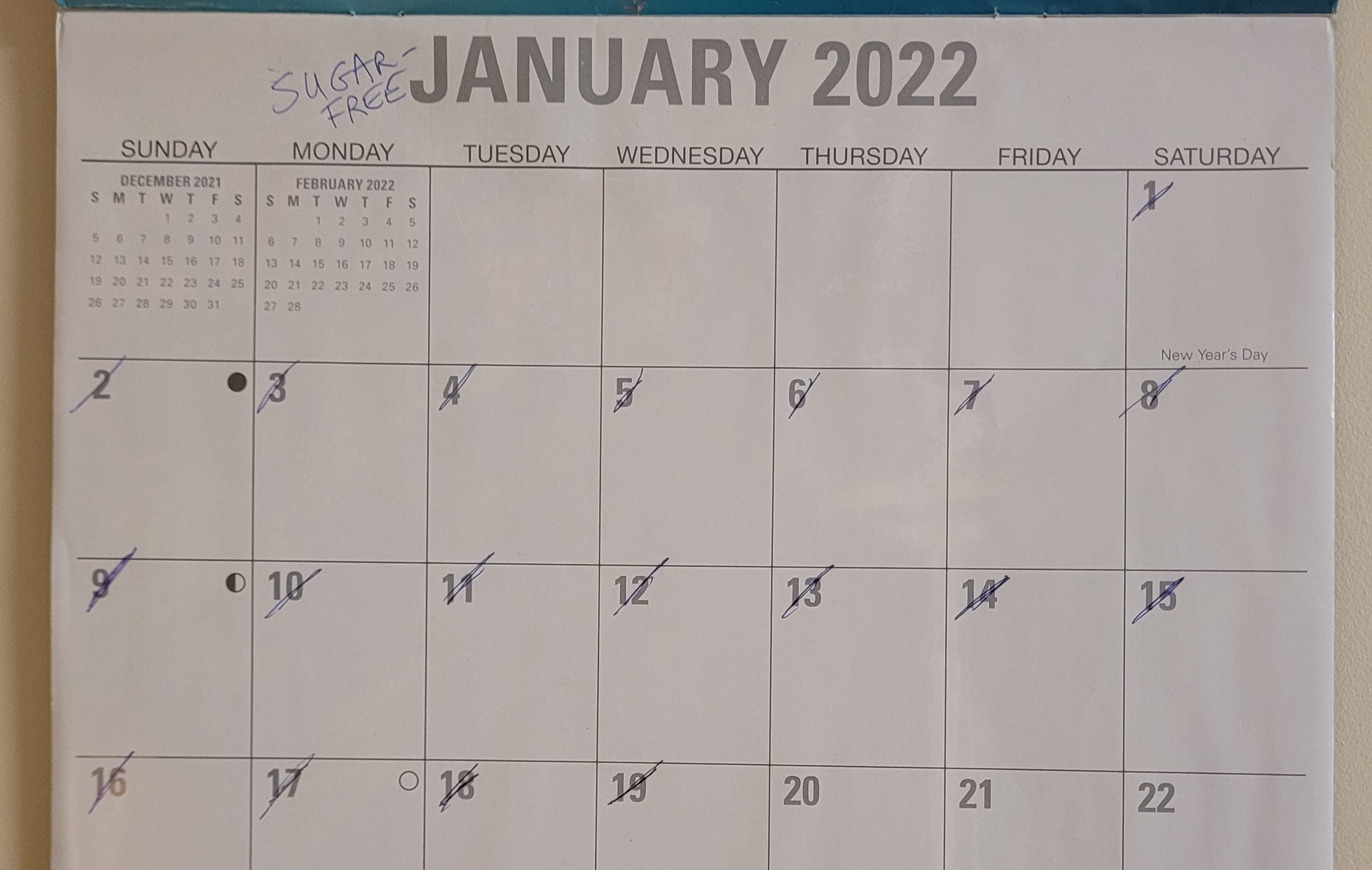Last year I gave up sugar, alcohol and caffeine for the month of January. I was joined by the rest of the family on the giving-up-sugar front. The idea was to make a hard break from the season of over-indulgence and break the cycle of bad eating and drinking habits that we had been developing. After a month-long abstinence, we went back to our various vices with a renewed appreciation for them, but without the slavish cravings that come from habitual consumption.
After our success last year, we decided to begin 2022 in the same way. I gave up the trifecta of caffeine, alcohol, and sugar, and the rest of the family gave up sugar.
This year we made some compromises. We would be allowed to eat cake. Well, at least one cake. Due to the omicron surge, two birthday and Christmas celebrations had been pushed into January. One of our relatives was set on baking a cake for us as she has in previous years. So a special instance was made for the eating of the cake. In the end, it was scoffed in two days.
We also had to decide how pure we were going to be with our sugar abstinence. Sugar is so ubiquitous in everyday food, our palettes are accustomed to many foods being extra sweet. For example, my kids have a predilection for Subway sandwiches, which have so much sugar in them that Ireland legally declared Subway bread buns are cake.
We didn’t want perfection to be the enemy of the good, so we aimed to reduce the obvious sugars (candies, sugary syrups, desserts, cookies, ice cream, sugary pies, etc.) and raise awareness about the hidden sugars. Subway sandwiches were allowed occasionally.
We were also concerned that the boys (13 and 8) would not eat their porridge oats for breakfast without the customary sweetening of maple syrup, so we allowed for a mixing in of a quarter teaspoon of maple syrup per serving with their breakfast, which is about a tenth of what some kids’ cereals typically contain (1g vs 10g or more of sugar per serving). Oats are a great start to the day. Cereals with an equivalent sugar amount were also acceptable.
I also occasionally allowed myself marmalade on my morning toast (last year, sugary spreads were out). My excuse: I had just received it for Christmas. Our eldest was allowed low-sugar jam on his pancakes and peanut butter sandwiches.
Other than that the main sugars we allowed ourselves were natural sugars from fruit. We ate a lot of fruit: fresh, frozen, raw, cooked, dried, sliced, squeezed, blended, on its own, mixed with others.
While this amounted to a heap of natural sugar, it’s not the kind of what we call “bad” sugar of candy bars, sugar-bowl sugar, and such like.
At this time of year, fresh fruit is more limited and good quality fresh fruit is expensive. We were spending $6-$8 for 1lb (16oz) of strawberries and $5-$6 for 170g (6 oz) raspberries or blackberries. These provided staples for packed lunches and after-school snacks.
It made me think that it would probably be easier, and more affordable, to go sugar-free in the summer months when fresh, tasty local fruit is abundant, but then January provides a chance to make a clean break from the Christmas excesses and set the tone for the new year.
Maybe we should do two months?
Coffee and booze
The experience for me was similar to the previous year with coffee. For the first few days, I had to endure the caffeine-withdrawal headache. I woke up with a nagging pain, felt its dull presence through the day and then went to bed with head still aching. In the first few days, it was difficult to concentrate on work. The headache subsided a little every morning, but only eventually disappeared after a week.
Without the boost of coffee and caffeinated tea, I also found initially my energy levels dissipated earlier in the day. I was early to bed and slept well, which is no bad thing. By the second week, I felt more on an even keel and didn’t experience quite the same rate of sloughing off of energy by evening time. By mid-month, I didn’t miss the caffeine buzz at all, although I still was vulnerable to a Pavlovian-like response when I heard the grinding of beans in the morning or if catching a whiff of freshly ground, Peruvian dark roast.
Like last year, steaming cups of strong rooibos tea made a great alternative to caffeinated drinks.
The big difference this year was there was no novelty to the month-long fast. We had proven ourselves last year. We knew we could do it. The challenge had been accepted and won (read about it here). The danger was that we would sit on our laurels and certainly as we passed the halfway mark on January 16 the voices of temptation were telling us to relent.
Having made a few concessions (like cake), the kids would argue for special instances, like when the youngest came home with a candy cane from teacher. “But just this once,” was the plaintive cry. Mum stashed it for later, encouraging him to stay the course.
Or, on another occasion, my eldest argued for ending the sugar fast a day early, “Because, Dad, most months have 30 days.”
Me: “And January? Why give up when you’ve come so far?”
Hopefully, these occasions provided experience in how to maintain one’s resolve, rather than providing justification for future candy bingeing.
Now that we’ve reset, the hard part will be maintaining a sugar-lite lifestyle, especially with bags of Halloween and Christmas candy still untouched. The circuit-breaker has given us time to remind ourselves that there are many pleasurable alternatives to sugary foods that are more healthy. We’ll be that bit more conscientious about what we consume, although no doubt we’ll need to reset once more at the end of the year.

